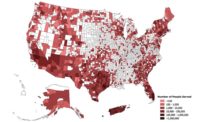
The recent drinking-water crisis brought on by algae blooms has put Toledo's water-quality troubles on the national stage. The issue is common: Runoff from urban and agricultural areas and wastewater treatment plants create hypoxia, or algae blooms, that choke oxygen for fish and other aquatic life and trap toxins, which can poison the water.
"Currently, we are seeing the impacts of nitrogen and phosphorus pollution, not only off the Louisiana Coast but around the country," says Matt Rota, senior policy director for the Gulf Restoration Network.
Just two days after residents of Toledo were advised not to drink their tap water in early August, scientists from the Louisiana Universities Marine Consortium released their annual measurement of the Gulf of Mexico's "dead zone." They said the dead zone measured 5,708 sq miles as of Aug. 1, on par with the average size for the past five years but three times larger than the target of 1,991 sq miles set by a federal-state task force in 2001.
Rota says voluntary measures have not been effective and called for numeric limits for nitrogen and phosphorus. The Natural Resources Defense Council and other conservation groups filed, in 2012, a lawsuit to force the U.S. Environmental Protection Agency to decide whether to set numeric limits for the Mississippi Watershed. That litigation is making its way through the courts.
Michael Schmidt, senior vice president at CDM Smith's Jacksonville office, says he is seeing more utilities ask for higher levels of treatment at wastewater plants in order to reduce the discharge of phosphorus and nitrogen. "Nutrients have not traditionally had numeric limits, but these are growing in need and implementation," he adds. Schmidt notes that a variety of solutions exist to reduce excess nutrients, including green infrastructure and low-impact development, riparian buffer protection and restoration, wastewater treatment-plant process upgrades and wastewater reuse.
Nathan Gardner-Andrews, general counsel for the National Association for Clean Water Agencies, says that although wastewater facilities already have done a fair amount to improve water quality, agriculture needs to step up, too. The recently enacted Farm Bill may help. The law encourages partnerships between clean-water utilities and farm groups. NACWA currently is working on an agreement with a federation of milk producers to transport waste from dairy farms to digesters at wastewater treatment plants. The additional waste would be used to create more energy that can power the treatment plants.





Post a comment to this article
Report Abusive Comment